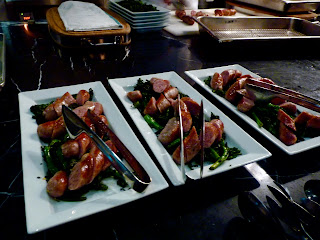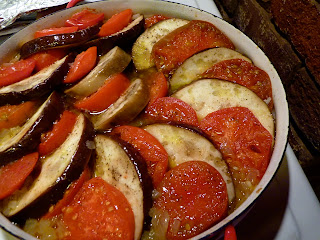That was after I mentioned that I would be making Swiss Chard Flan for dinner. To him the idea of swiss chard and flan in the same meal was completely unappetizing.

Being the horribly indecisive person that I can be, his comments through me for a loop. My whole plan for dinner was flying out the window.
Should I switch to couscous? Not pasta again. It's Meatfree Monday! What do I cook?
After a few hours of that nonsense, I came back to my original plan -- Swiss Chard Flan from Canal House Cooking Volume 1. I promise I am going to stop with all of this Canal House Cooking Volume 1 business.

Easy for me to say, because I just purchased the next three volumes! I am a very proud owner. Please go to the Canal House website, buy their books, and become a subscriber. As I've mentioned before, Christopher Hirsheimer and Melissa Hamilton are capturing the spirit of food, good cooking, and swell living in exactly the manner that I would like to. Their style is simple and seasonal. Their photography is gorgeous.
Go see!
The Canal House women are using the term flan loosely. My efforts did not produce a creamy custard. This particular flan is more closely related to a frittata. Certainly, there are fewer eggs and more cream here, but in no way are you getting a crème caramel with greens in it.

The shopping list is short -- olive oil, onions, garlic, swiss chard, half-and-half, heavy cream, eggs, and parmigiano-reggiano. You probably have most of that in your kitchen already. The preparation is quick. The cooking time is about an hour.
Just start early, because the idea is to eat the flan at room temperature. Needless to stay, starting to prepare this dish at 8:15 at night will likely mean you are eating your flan, hot. This is not necessarily the end of the world. It was quite tasty hot, but eating it at room temperature for lunch today was better.

You chop. You sauté. You wait.
The recipe suggests you use two bunches of chard. Oh, how I hate that kind of instruction. The size of a bunch of chard is so variable. I used one and a half bunches. It was about six cups of chopped leaves. This seemed like plenty of chard. Perhaps the dish would have been more custardy with less. I was satisfied with the egg to vegetable ratio.
One other note on the chard. Give it a spin after washing it. Just as with the Spinach Cake, you do not want a watery final product. Without spinning the greens, you will likely have a flan that is leaking puddles of liquid.

After all the sautéing, you pour the egg and cream mixture over the vegetables. The recipe gives you the option to cook the dish entirely in the oven or on the stove for twenty minutes with a quick finish under the broiler. I opted for the latter.


The parmigiano-reggiano sprinkled over the flan will turn a deeper golden brown under the broiler. I used a modest amount of the cheese -- just enough to lightly finish the dish. You don't need much. There is already a cup of half-and-half and a half cup of heavy cream here.
No need to further overdo it.

That being said, this dish does not seem at all heavy. It has quite a lot of chard in it. So while you may feel a little guilty about the cream, you do feel quite virtuous about all the greens you are eating. The chard has a wonderful sweet flavor that is nicely complemented by the salty cheese.
We ate the swiss chard flan with a bit of warm bread and a crisp green salad, dressed with olive oil, lemon, garlic and anchovy. Not bad for a Monday. Also most appreciated by myself and Fe, this Tuesday.

Swiss Chard Flan
3 tablespoons extra-virgin olive oil
1 large yellow onion, chopped
1 clove garlic, minced
2 bunches young chard, stems and leaves chopped separately
3 eggs
1 cup half-and-half
1/2 cup heavy cream
Salt and pepper
Grated parmigiano-reggiano
Heat the olive oil in a large non-stick heavy skillet over medium heat. Add the onions and garlic and cook for about five minutes, until tender. Add the chard stems and cook covered for 10 minutes. Add the leaves and cook covered until wilted, about 10 minutes
Beat the eggs, half-and-half, and cream in a bowl. When the chard has wilted, season it with salt and pepper. Pour the egg mixture over the chard. Reduce the heat to low, cover and cook until the custard has just set, approximately 20 minutes. It may still be a bit jiggly in the center.
Preheat the broiler. Sprinkle the cheese over the top, and brown the flan under the broiler. If the handle of your skillet is not ovenproof, leave the door ajar. Serve the flan from the pan or from a platter. Serve at room temperature.
Or cook the flan in a pre-heated 375 degree oven the whole time. It will take about 45 minutes.
Serves 4-6










































